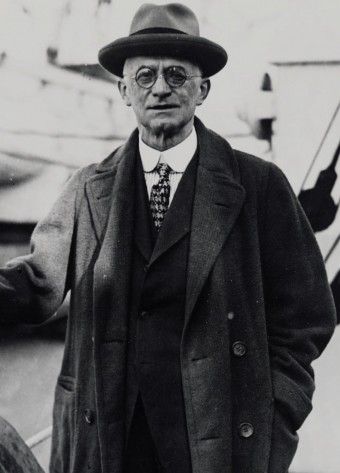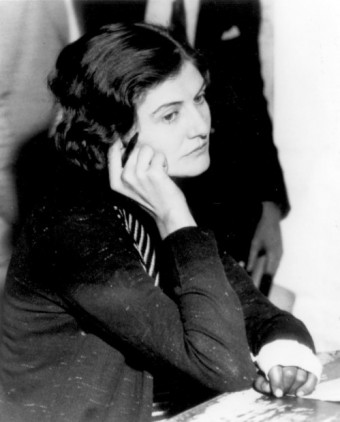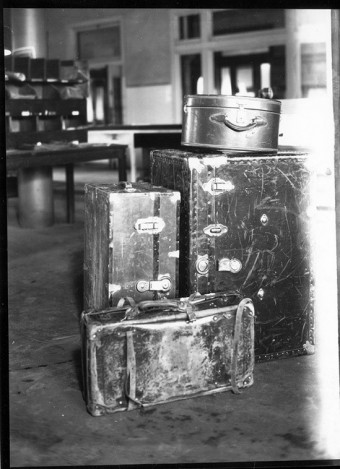#Information / Worldwide |
The Timely Death of Kodak Founder George Eastman Posted: 16 Oct 2015 09:18 AM PDT
Cheerfully signing the will, he assured his friends this was just a matter of ensuring his wishes. Later, it was thought that he also wanted his friends to see him mentally alert so the credibility of the will wouldn't be questioned. After all the t's were crossed and i's were dotted, he asked if everyone could excuse themselves for a moment. When they did, George took out paper and pen and wrote a note, which read,
Then, he took a pistol out from his nightstand and shot himself in the heart, ending his life at the age of 74. So who was this captain of industry and why did he, quite cheerfully, suddenly choose to take his own life? George Eastman, and his company, turned photography from a complicated, expensive, unwieldy, and potentially dangerous hobby (due the chemicals needed to develop the film) into one that, quite literally, a child could do. He was not only a genius inventor, but a brilliant marketer. His story begins as it ended, in Rochester. The Eastmans always put a priority on education. In fact, George Eastman Senior founded Eastman's Commercial College in 1854, the same year George Junior was born. The family was middle-class and living pretty comfortably, but this was short-lived. In 1862, when George was only eight, his father passed away from a "brain disorder." His mother, Maria, was a now a widow with three small children, one of them (George's youngest sister Katy) suffered from polio and other illnesses. Life was hard for the Eastman family after George Senior's death and self-reliance became a necessary trait. At age of 14, George dropped out of high school to support his family. He worked at a local insurance company and as a clerk at Rochester Savings Bank. Then, in 1870, tragedy struck again when his sister, Katy, passed away from complications related to polio. She was buried next to her father. George, even at an early age, was meticulous, detailed, and controlling of every aspect of his own business. Starting when he got his first job at 14, he began keeping ledgers to detail his finances. Due to his careful planning and earning enough working at the bank, Eastman was able to afford certain luxuries. It was in one of these ledgers, under January 27, 1869 to be exact, that "photography" was first mentioned. As the months passed, besides helping to support his mother, George spent more and more money on "photos" or "photograph materials." In 1878, Eastman learned an important lesson – photography (at least at the time) was hard. The legend goes that he wanted to treat his mother to a vacation in Santa Domingo in the Dominican Republic (other sources say he was looking to buy land in the newly independent nation). Either way, to document his trip, he bought a photographic outfit. Cameras then are not what we think of cameras are today. An outfit included the camera (constructed from several parts that must be put together before taking pictures), a stand, a light, and wet glass plates (with chemicals) in order to preserve the picture. As Eastman later put it,
Eastman, so fed up with everything he had to bring, not only didn't take a camera, he didn't take the trip at all. At this point, Eastman thought to himself that there had to be a better way. For the next several years, while still working at the bank, Eastman developed a new kind of dry plate, one made out of gelatin (the same ingredient used in Jello, which would be invented twenty years later in a small town thirty miles from Rochester), not glass. Glass was heavy, fragile, and expensive. Gelatin was an improvement on all of these things. By 1880, he had patented a dry-plate coating machine made out of gelatin, making the process of preserving film negatives simpler, cheaper, and less dangerous. While developing this process, he came across another innovation that would allow photography and, eventually, cameras to become something that wasn't just for the professional. As described by Eastman,
He patented this film on March 4, 1884. That same year, Eastman and his associate William Walker developed a roll holder to hold the film. The invention of this revolutionary film wasn’t enough, though. What he really wanted to do was, "to popularize photography to an extent as yet scarcely dreamed of." In 1888, the name "Kodak" was thought up while playing with an anagram set with his mother. Eastman loved the word because it was simple, easy to pronounce and it started with a "K." Said Eastman, "It became a question of trying out a great number of combinations of letters that made words starting and ending with 'K." Kodak was officially incorporated as a company in 1890 and quickly rocketed to the top of the industry. Also that same year, Eastman introduced the first Kodak camera, equipped with his film. It cost $25 (about $640 today), but the most important thing was that the customer didn't do the developing of film themselves- Kodak did. The customer would send the camera back (film and all) to the company for developing and processing. Their motto aptly illustrated this: “You press the button, we do the rest.” He had now made it easy for anyone to take and have pictures developed. The next step was to change the camera from a luxury item or expensive hobby to something just about anyone could afford. In 1900, the revolutionary Brownie camera, versions of which were so popular through the mid-20th century, was born. It cost only one dollar ($28 today) and was even marketed to children. For the next hundred years, George Eastman and Kodak would be synonymous with cameras and film. For his entire 40+ years of heading up his own company, George Eastman was used to being in control. So, when he was diagnosed with a spinal condition in the late 1920s, forcing him to be confined to a wheelchair, it depressed him greatly. His mother, who lived with him until her death in 1907, was also in a wheelchair for the last years of her life. His baby sister was in a wheelchair until she died. He saw them suffer and Eastman did not want to go through the same long drawn out process. He also didn't like that he felt this gave off an image of weakness. Eastman was used to being a man respected the world over, not an "invalid." He mused greatly about death and illness, writing a friend,
So, by March 1932, he had enough. George Eastman wanted to go by his own hand, rather than the hand of illness and fate. So he tidied up all the loose ends of his life and, once complete, ended it immediately on his own terms. If you liked this article, you might also enjoy:
Bonus Facts:
The post The Timely Death of Kodak Founder George Eastman appeared first on Today I Found Out. |
This Day in History: October 16th- The Truth About Ruth Judd and Her Infamous Murders Posted: 16 Oct 2015 12:00 AM PDT This Day In History: October 16, 1931
What happened on the night of October 16, 1931 leading up to the murders is unclear and accounts from the only (then surviving) person who is known to have definitely been an eye-witness, Ruth Judd, varied a bit from telling to telling. What is known for certain is that Ruth went over to the residence of Agnes "Anne" LeRoi, 32, and Hedvig "Sammy" Samuelson, 24. It's alleged that all three were having affairs with Halloran and that Anne liked to rile Ruth up with accounts of her own sexual adventures with the studly businessman, particularly playing on the fact that Judd was in love with Halloran, while Anne was just using him for money. At some point someone pulled a gun and Anne and Sammy were both fatally shot while Ruth received a gunshot wound on her left hand. Three days later, a railroad worker at Central Station in Los Angeles caught a whiff of an incredibly repugnant smell. He looked in the direction it was coming from and saw trunks seeping what looked like blood. At the time it was thought perhaps it was just animal blood, with someone transporting a deer or the like. As for Judd, she claimed she didn't have the keys to open the trunks on her and left the scene, meeting with her brother and, according to police interviews with him, asking him to come get the trunks and then dispose of them in the ocean for her.
For her part, Judd had several slight variations of the story of what happened that night on tap over the course of the trial, though she never took the stand to give her testimony under oath. The central theme of all the tales was that on the night in question she was attacked and only fired her gun in self defense. (Although why she had a gun on her at all at the time was never clear.) She also always stated that Halloran had supposedly entered the mix and took control of the situation for her, assuring her that as long as she did exactly what he told her, he'd use his considerable influence to make sure she didn't go to jail. She also stated he then called in a friend who was a doctor to chop up the bodies and sent her on her way to LA to dispose of them. Of course, why such a doctor would help in the first place and why Halloran would suggest bringing in a witness to the fact that he was helping a murderer dispose of bodies isn’t really clear. If he was really helping her, it would have been much easier (and safer) to take her in his car out to the desert to dispose of the whole bodies that way. Still not an ideal scenario, but certainly better than what she claimed happened. Nevertheless, when details of Judd and Halloran’s relationship got out, he was going to be tried as an accessory to murder, but the charges were eventually dropped, as the judge concluded any attempt to prosecute him would be "an idle gesture," this despite the fact that rumor had it (whether true or not, isn’t clear) that Halloran’s car had been seen at the apartment on the night in question and the next day. This led many to wonder if Judd was being sacrificed to spare the well-connected Halloran, who insisted that Judd's tale was "the story of an insane person." As for Judd, she stated, “I am going to be hanged for something Jack Halloran is responsible for … I was convicted of murder, but I shot in self-defense. Jack Halloran removed every bit of evidence. He is responsible for me going through all this. He is guilty of anything I am guilty of.” In the end, the jury found her, and her alone, guilty and did indeed sentence her to hang. However, days before her scheduled execution in 1933, she was declared insane and sent to the Arizona State Insane Asylum. During her several decades in the asylum, she managed to escape a whopping seven times. The last time she broke out she remained at large for six years under the alias of Marian Lane, working as a nanny for a wealthy family in northern California. The police finally caught up with her in 1969, and Judd began legal proceedings to reopen her case. In December of 1971, she was granted a pardon by Arizona Governor Jack Williams. Judd returned to northern California and her life as “Marian,” eventually dying in her sleep in 1998 at the age of 93. But that’s not the end of the story. After nearly a century of rampant speculation in various books and articles written on the case, it would seem that perhaps the truth has finally come out. In 2002, a 19 page confession letter written by Judd’s own hand from all the way back in April of 1933 was donated and added to the Arizona state archives, with no one giving it any notice until 2014. In the confession, Judd in great detail described to her lawyer planning and executing the murder (she had originally only intended to kill Anne). According to her confession, she did it all by her lonesome every step of the way. She opened the letter stating, “I am writing the absolute truth of this case, in full confidence, that you will use it as you see fit in your best judgment. Mr. Richardson, I have full confidence in you and trust you.” And that
Unsurprisingly, her lawyer wasn’t interested in revealing the existence of the letter, let alone its contents, to the court. Instead, after reading the confession, he promptly hid it away in a safety deposit box where it sat until being donated to the Arizona State Archives a little over a decade ago. So, case closed right? Well, it has been speculated that the confession may have just been a carefully made up version of what really happened. The hypothesis here is that in writing the letter and frequently citing how she was “insane,” then subsequently trying to kill herself after writing it, she was just trying to avoid the noose. (At the time, you couldn’t use insanity as a defense unless you actually confessed to the crime in question.) Of course, trying to kill yourself to avoid being sentenced to death seems a bit of an odd strategy… But, she wasn’t successful, so if that was really her plan, it worked out OK in that respect. As for her final lawyer, Larry Debus who she employed the services of in 1969, he stated after reading the letter, “It’s the first version of her story I’ve ever read that really matches up with things she told me privately.” If you liked this article, you might also enjoy:
The post This Day in History: October 16th- The Truth About Ruth Judd and Her Infamous Murders appeared first on Today I Found Out. |
| You are subscribed to email updates from Today I Found Out. To stop receiving these emails, you may unsubscribe now. | Email delivery powered by Google |
| Google Inc., 1600 Amphitheatre Parkway, Mountain View, CA 94043, United States | |


